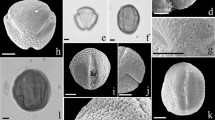Abstract
Microfossils which matchLactoris (Lactoridaceae) pollen more closely than those of any other living angiosperm occur in Campanian to Paleogene sediments around the margins of Australia. These are referred to the fossil genus Lactoripollenites (Zavada & Benson 1987). A species belonging to the same genus occurs in older (Turonian-Santonian) deposits off southern Africa but Australian specimens represent not only the most southern, but also the youngest known (Oligocene) records to date. Our data support suggestions that theLactoridaceae were widespread across the Southern Hemisphere during the Late Cretaceous (Lammers & al. 1986,Zavada & Benson 1987). An homology between gymnosperm sacci and the saccus-like structures found in Lactoripollenites and some specimens ofLactoris pollen is contested, as is the use of (anasulcate) apertures to support the primitive position of the family.
Similar content being viewed by others
References
Bradshaw, J., Yeates, A. N., Beyton, R. M., Brakel, A. T., Langford, R. P., Totterall, J. M., Yeung, M., 1988: Palaeogeographic evolution of the North-West Shelf region. — InPurcell, P. G., Purcell, R. R., (Eds): The North West Shelf, Australia, pp. 29–53. — Perth, Petroleum Exploration Society of Australia.
Carlquist, S., 1964: Morphology and relationships ofLactoridaceae. — Aliso5: 421–435.
—, 1990: Wood anatomy and relationships ofLactoriadaceae. — Amer. J. Bot.77: 1498–1505.
Chase, M. W., & 41 others, 1993: Phylogenetics of seed plants: an analysis of nucleotide sequences from the plastid greenrbcL. — Ann. Missouri Bot. Gard.80: 528–580.
Crane, M. W., 1990: The phylogenetic context of mircosporogenesis. — InBlackmore, S., Knox, R. B., (Eds): Microspores: evolution and ontology, pp. 11–41. — London: Academic Press.
Friis, E. M., Pedersen, K. R., 1995: The origin and early diversification of angiosperms. — Nature374: 27–33.
Crawford, D. T., Stuessy, T. F., Silva, M. O., 1986: Leaf flavonoid chemistry and the relationships of theLactoridaceae. — Pl. Syst. Evol153: 133–139.
Endress, P. K., 1994: Floral structure and evolution of primitive angiosperms: recent advances. — Pl. Syst. Evol.192: 79–97.
Erdtman, G., 1966: Pollen morphology and plant taxonomy. I. Angiosperms. — London, New York: Hafner [Offset edn.]
Friis, E. M., Endress, P. K., 1990: Origins and evolution of angiosperm flowers. — Advances Bot. Res.17: 100–162.
Helby, R., Morgan, R., Partridge, A. P., 1987: A palynological zonation of the Australian Mesozoic. — Assoc. Australas. Palaeontologists Mem.4: 1–94.
Heywood, V. H., 1978: Flowering plants of the world. — Oxford: Oxford University Press.
Hickey, L. J., Taylor, D. W., 1993:Eoangiospermidae — a new subclass for the basal angiosperms. — Amer. J. Bot.80: 123–124.
Hill, R. S., Scriven, L. J., 1995: The angiosperm-dominated woody vegetation of Antarctica: a review. — Rev. Palaeobot. Palynol.86: 175–198.
Kremp, G. O. W., 1965: Morphologic encyclopaedia of palynology. — Tuscon: University of Arizona Press.
Kurmann, M. H., Zavada, M. S., 1994: Pollen morphological diversity in extant and fossil gymnosperms. — InKurmann, M. H., Doyle, J. A., (Eds): Ultrastructure of fossil pollen and spores, pp. 123–137. — Richmond: Royal Botanic Gardens, Kew.
Lammers, T. G., Stuessy, T. F., Silva, M. O., 1986: Systematic relationships of theLactoridaceae, an endemic family of the Juan Fernandez Islands, Chile. — Pl. Syst. Evol.152: 243–266.
Macphail, M. K., Colhoun, E. A., Kiernan, K., Hannan, D., 1993: Glacial climates in the Antarctic region during the late Paleogene: evidence from nothwest Tasmania, Australia. — Geology21: 145–148.
—, 1994: Early Tertiary vegetation: evidence from pollen and spores. — InHill, R. S., (Ed.): The history of the Australian vegetation: Cretaceous to recent, pp. 189–261. — Cambridge: Cambridge University Press.
McMinn, A., 1988: Outline of a Late Cretaceous dinoflagellate zonation of northwesern Australia. — Alcheringa12: 137–156.
Osborn, J. M., Taylor, T. N., 1994: Comparitive ultrastructure of fossil gymnosperm pollen and its phylogenetic implications. — InKurmann, M. H., Doyle, J. A., (Eds): Ultrastructure of fossil pollen and spores, pp. 99–121. — Richmond: Royal Botanic Gardens, Kew.
Partridge, A. P., 1976: The geological expression of eustacy in the Gippsland Basin. — APEA Journal: 73–79.
Pedersen, K. R., Friis, E. M., Crane, P. R., 1994: Ultrastructure of pollen fromCretaceous angiosperm reproductive structures. — InKurmann, M. H., Doyle, J. A., (Eds.): Ultrastructure of fossil pollen and spores, pp. 139–159. — Richmond: Royal Botanic Gardens, Kew.
Pole, M. S., Macphail, M. K., 1996: EoceneNypa from Regatta Point, Tasmania. — Rev. Palaeobot. Palynol.92: 55–67.
Sampson, F. B., 1995: Pollen morphology ofLactoridaceae — re-examination. — Grana34: 100–107.
Seisser, W. G., 1995: Paleoproductivity of the Indian Ocean during the Tertriary Period. — Global Planet. Change11: 71–88.
Stover, L. E., Partridge, A. P., 1973: Tertiary and Late Cretaceous spores and pollen from the Gippsland Basin, southeastern Australia. — Proc. Roy. Soc. Victoria85: 237–286.
Takhtajan, A., 1980: Outline of the classification of the flowering plants (Magnoliophyta). — Bot. Rev.46: 225–359.
Traverse, A., 1988: Paleopalynology. — Boston: Unwin Hyman.
Walker, W. J., 1974: Evolution of exine structure in the pollen of primitive angiosperms. — Amer. J. Bot.61: 891–902.
Zachos, J. C., Stott, L. D., Lohmann, K. C., 1994: Evolution of early Cenozoic marine temperatures. — Paleoceanography9: 353–387.
Zavada, M. S., Benson, J. M., 1987: First fossil evidence for the primitive angiosperm familyLactoridaceae. — Amer. J. Bot.74: 1590–1594.
—, 1986: Pollen morphology ofLactoridaceae. — Pl. Syst. Evol.154: 31–39.
Author information
Authors and Affiliations
Rights and permissions
About this article
Cite this article
Macphail, M.K., Partridge, A.D. & Truswell, E.M. Fossil pollen records of the problematical primitive angiosperm familyLactoridaceae in Australia. Pl Syst Evol 214, 199–210 (1999). https://doi.org/10.1007/BF00985739
Received:
Revised:
Issue Date:
DOI: https://doi.org/10.1007/BF00985739




